Paving Comparison Guide
Choosing paving materials for your new patio can seem a little daunting - and understandably so. The decision you make will probably have the biggest impact on the final appearance of your patio! This paving comparison guide will help you choose paving that's right for you.
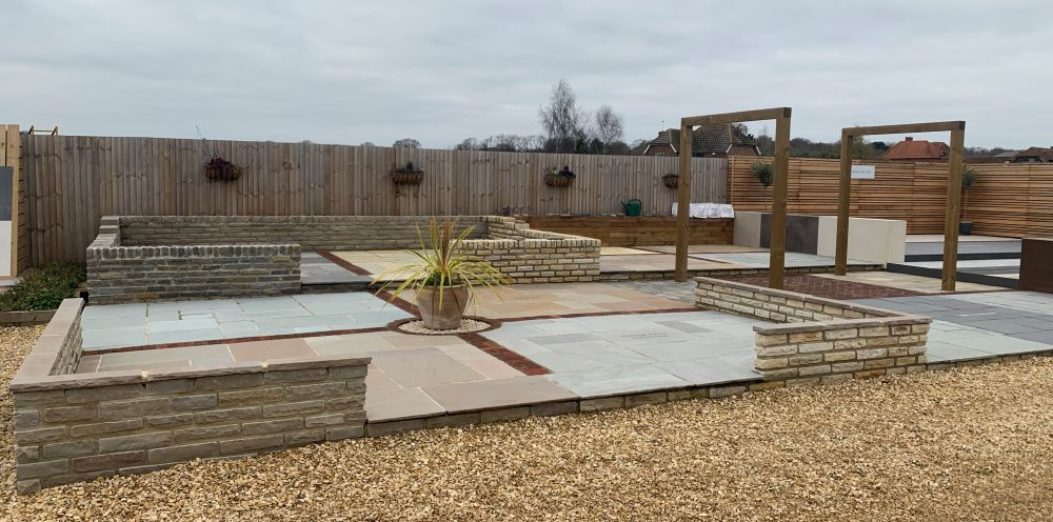
Introduction to ALDA’s Paving Comparison Guide
Porcelain, concrete, sandstone, limestone, slate, granite, travertine, as well as gravel brick, block, setts, … the list goes on! Gone are the days when the only choices were concrete paving, brick or very expensive natural stone; the introduction of relatively inexpensive imported sandstones and limestones (particularly those from India), together with a huge variety of porcelain, means that there is now a huge and mind-boggling array of different materials and colours to choose from.
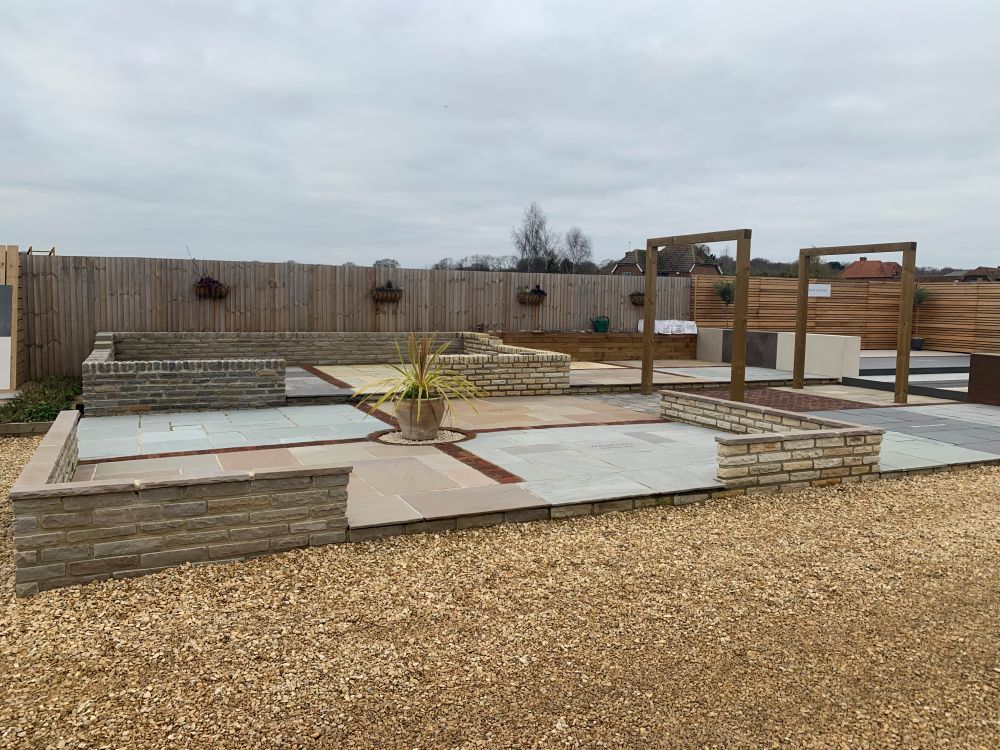
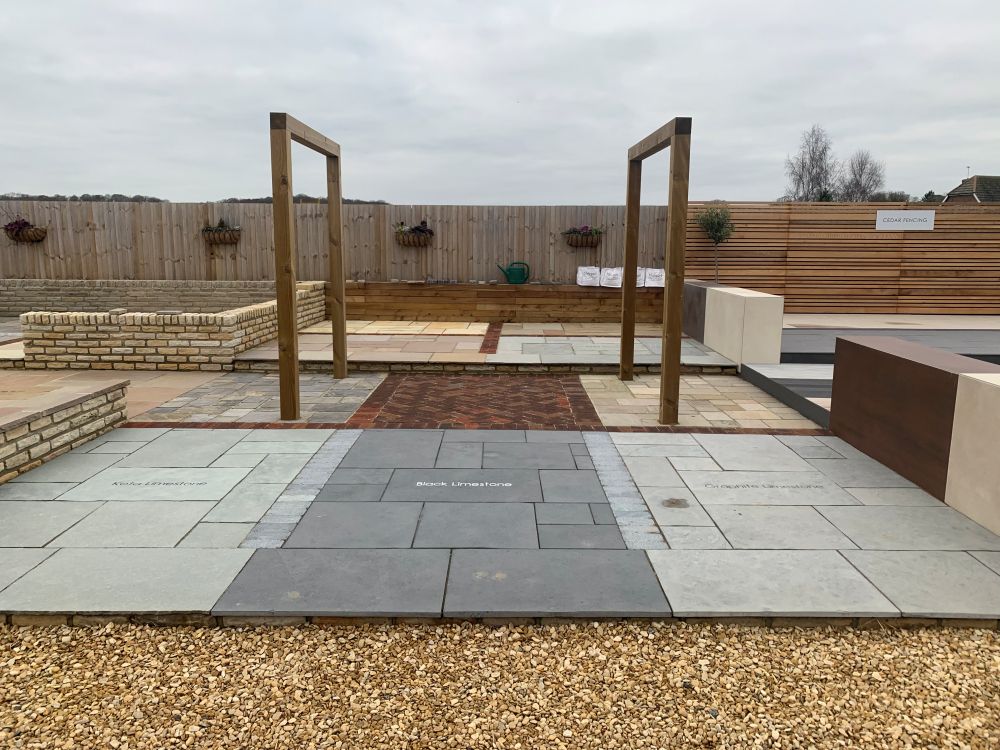
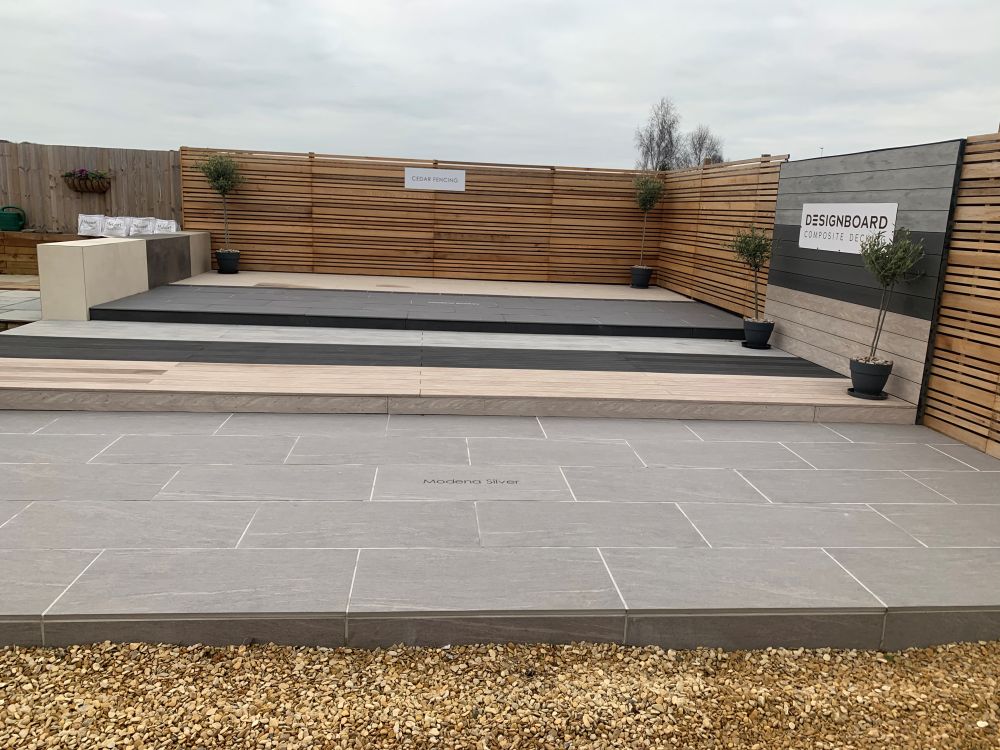
In addition, the natural stones can be plain hand cut, or tumbled, or sawn / honed. And they come in a variety of different colours. Indeed with Indian sandstone, there is a wide variety of shades within each individual “colour”. And of course, the different materials are often mixed for optimum effect – gravel areas within paving for example, or a brick edging.
It’s no wonder if you’re feeling a little overwhelmed with all the option available to you!
This paving material comparison guide provides an overview of different materials, before looking at some other key areas to consider before deciding on your new patio material.
All of the patios shown here have been designed and installed by ALDA’s in-house team. Ned help designing your patio? Please contact us.
Paving Comparison Table
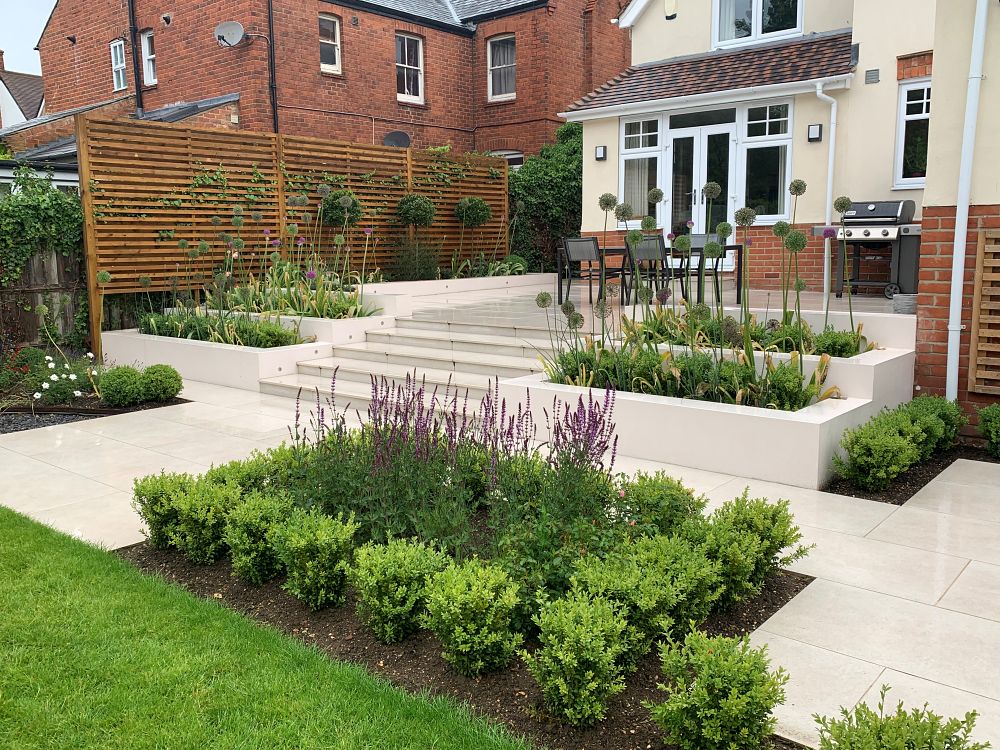 Porcelain More Details | 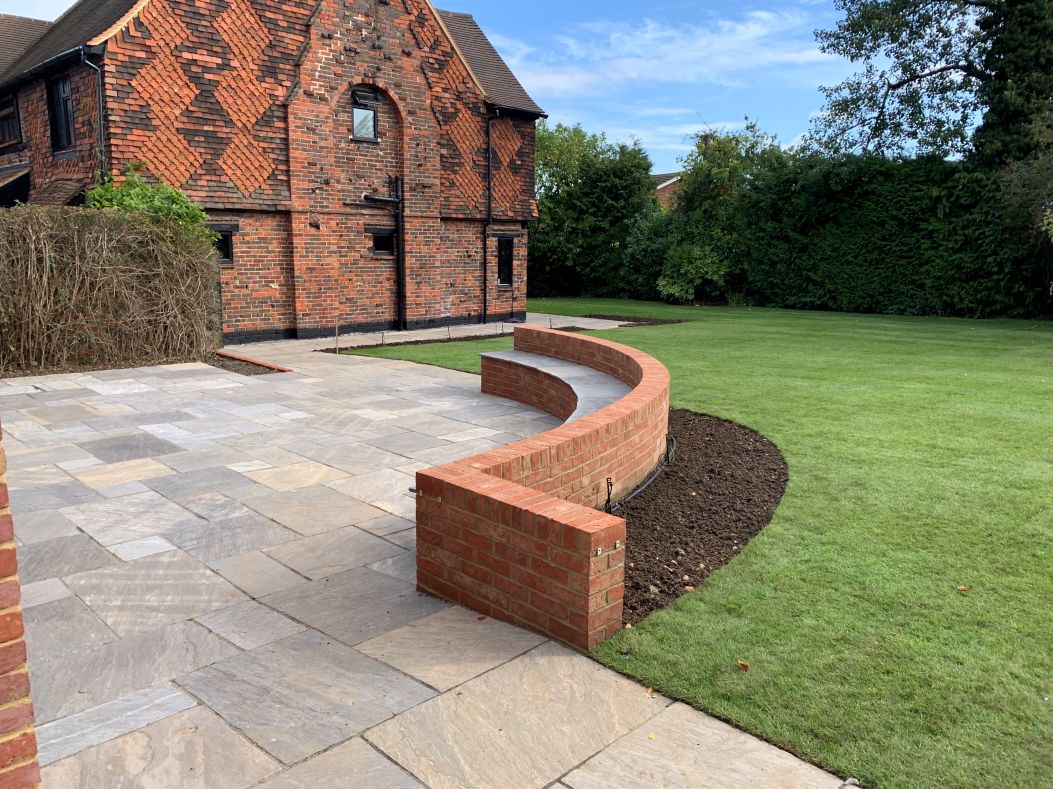 Indian Sandstone More Details | 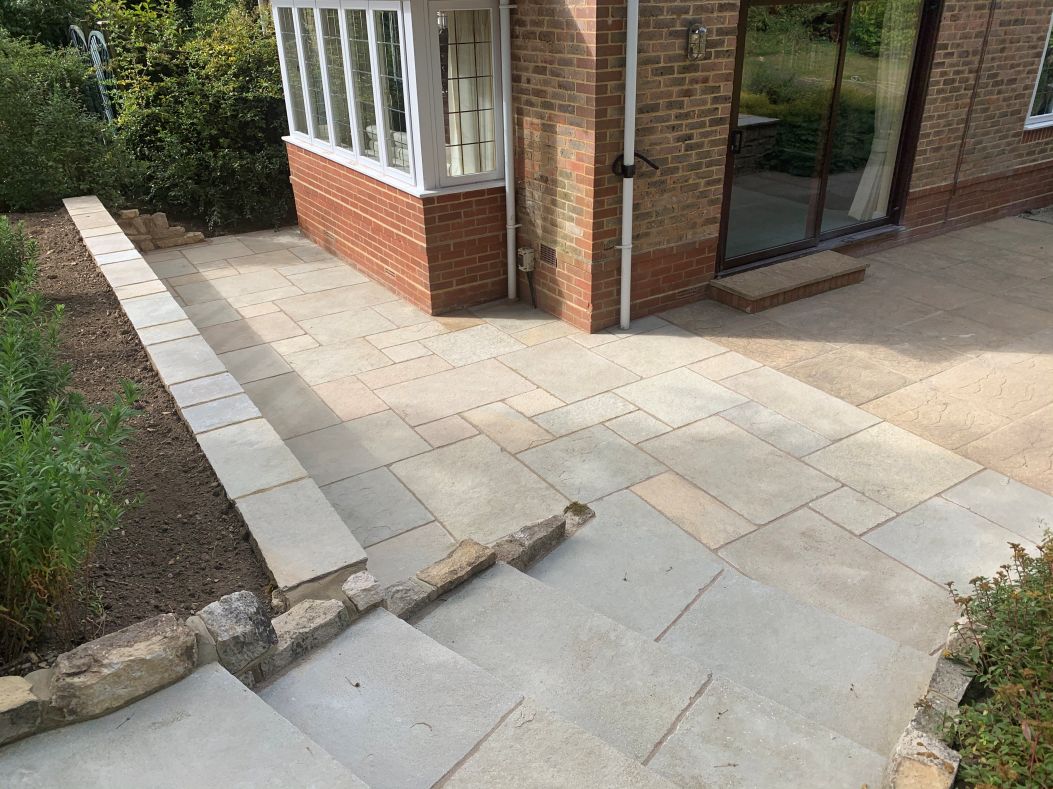 Limestone More Details | 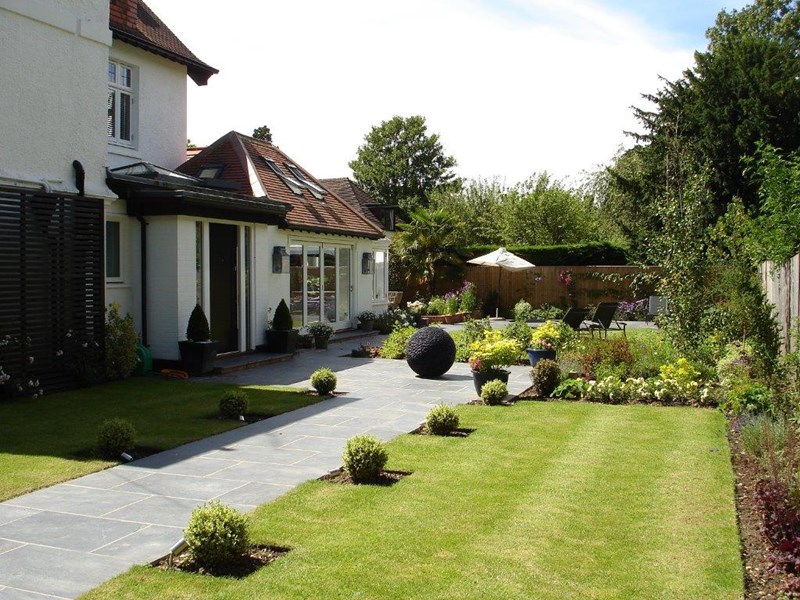 Slate More Details | 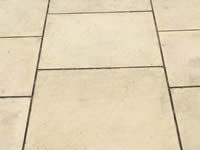 Yorkstone More Details |  Granite More Details | |
|---|---|---|---|---|---|---|
| Description | Man-made product with a highly consistent colour and texture variation. | Natural product | Natural product with a less riven texture than sandstone. | Natural stone with a striking appearance. | Natural strength and timeless beauty. | Highly durable, natural product |
| Style Notes | Ideal for contemporary spaces and a seamless transition from indoor to outdoor living. | Compliments most planting schemes – use a riven or tumbled finish for a more vintage, time worn appeal, or sawn for a more contemporary feel. | The tumbled finish is a good choice for traditional gardens; sawn limestone is perfect for providing a clean look in the contemporary garden. | A striking appearance. Can be laid internally and externally to provide a smooth transition from home to garden. | A more obvious choice for traditional style gardens, but sawn edge Yorkstone also works well in the contemporary garden. | An elegant choice for more formal outdoor spaces. |
| Surface Finish | Smooth | Riven Tumbled Sawn / Honed | Riven Tumbled Sawn / Honed | Sawn edged, relatively smooth surface. | Riven Hand Fettled Sawn | Smooth Riven, natural finish |
| Colour Range | Comes in a wide variety of colours including black, many shades of grey, through to cream and mocha tone and even wood effect. | A range of mainly subtle colours. Names vary between suppliers but popular choices include Autumn Brown, Buff Blend, Mint, Grey and Raj Mix. | Comes in a variety of colours, such as Cotswold Yellow, Antique Yellow, Kota Blue, Black | Normally associated with the grey/black, but depending on the composition/source, is also available in blue, green, purple and copper. | Ranges from buff to a blue/grey depending on the bed of stone being worked; more limited colour choice than other materials. | Huge variety of colours, ranging from grey and blue through to tan, brown, green and red. |
| Slip Resistance | Slip resistant surface. | Slip resistant; even a sawn sandstone patio when wet has good slip resistance. | Relatively good, although not quite as good as sandstone & porcelain. | Relatively good – similar to limestone. | Algae and mould build-up over time can make for a slippery surface. This can be avoided by annual cleaning and/or applying a sealant. | Average slip resistance |
| Strength & Durability | Very hard wearing | Hard wearing, but less so than limestone | Very good – not as porous as sandstone | Hard wearing | Comparable with sandstone. | Highly durable! Nothing can beat granite for durability. |
| Maintenance | Top marks when it comes to maintenance. Porcelain is stain resistant and impermeable to moss, mould and algae. | Algae may build up over the years, particularly on a north facing patio. Using a sealant should prevent this. | A good low maintenance choice. Limestone’s natural strength and low porosity keep it looking good for years. Can still be susceptible to algae, so should ideally be cleaned once a year. | Lower quality slate can flake/chip. Depending on your colour choice, it may fade over time; susceptible to moisture damage. To add to its longevity a protective sealant can be applied once the paving has been laid. Best used in more protected areas. | A higher maintenance option. Over time the stone can become dark grey in colour due to the build-up of algae and mould. This can be avoided by annual cleaning or applying a sealant. | Good maintenance – as with most paving, clean once a year. |
| Cost | Used to be more expensive than most of its competitors, although has come down in price & now more comparable to limestone (lower price ranges). More labour intensive to install; smaller joints require more precise cutting. | The most economical of the natural stones. | Generally a reasonably priced paving product, although usually more expensive than sandstone. | Comparatively expensive – at the time of writing, normally a third more than sandstone paving. | The beauty of Yorkstone comes at a price. Currently it is one of, if not the most expensive form of paving. | The hardness of granite makes it relatively difficult to quarry and work, so it’s usually a more expensive option, although this does depend on the quality of the granite. |
| More on Porcelain | More on Sandstone | More on Limestone | More on Slate | More on Yorkstone | More on Granite |
Which Surface Finish?
Many paving materials – the natural stones in particular – are available in several different finishes. Your choice of finish can make almost as big a difference to the appearance of you patio as the choice of material in the first place.
Generally speaking, a sawn/honed finish is used for a more contemporary feel; riven, tumbled or hand fettled stone is used in more traditional spaces.
- Riven / Hand Cut: A rustic riven surface. This is generally the cheapest option, as it is how the stone comes out of the quarry.
- Tumbled: Processed for a softer finish, with rounded edges and corners. Great for a vintage, time worn appearance.
- Sawn / Honed: Often sawn on all six sides & either honed or sandblasted to give a contemporary look. This option is generally the most expensive, as it involves the most processing.
- Hand Fettled: Specific to Yorkstone, hand fettled paving is hand made, with the edges of each piece being fettled in the traditional manner using a hammer and chisel.
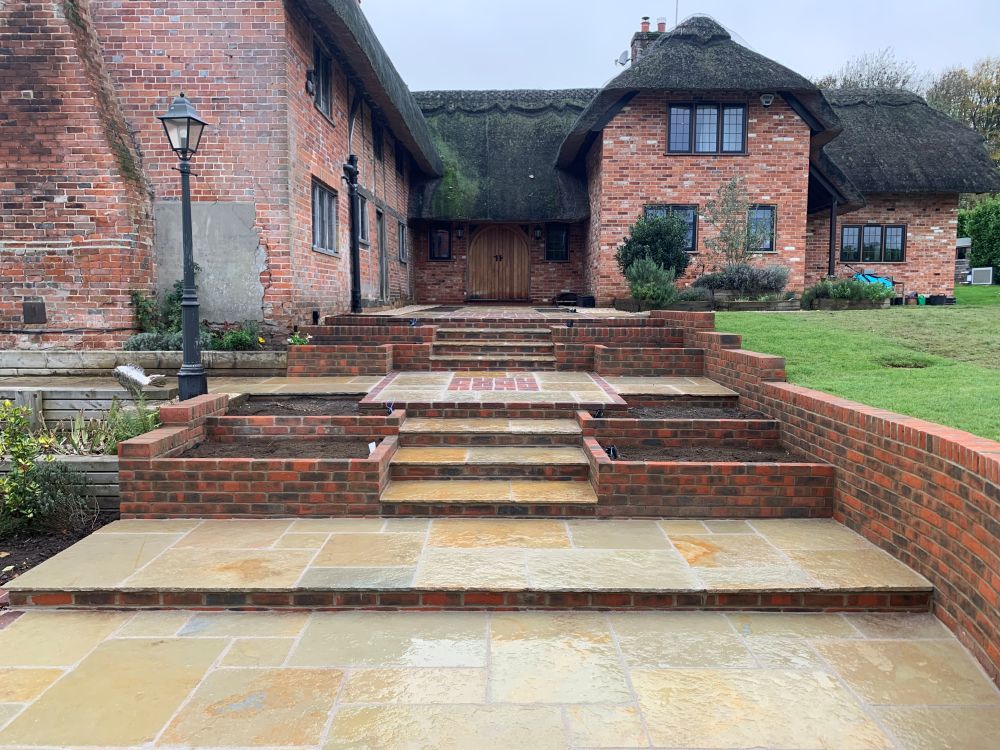
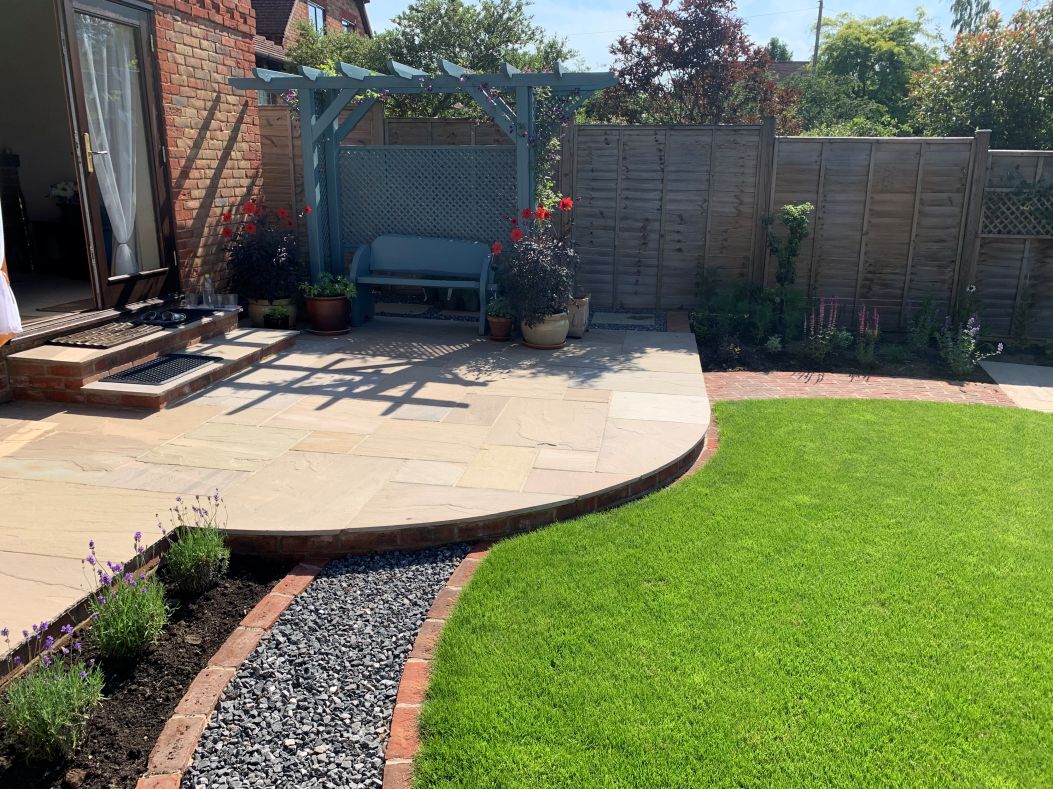
Should I Have My Patio Sealed?
As with so many things – it depends. Good patio sealant (we use STAIN-PROOF®, formerly known as Dry-Treat®) is relatively expensive to buy, so it’s worth thinking about how much you stand to gain before jumping in.
The key decision factors are the paving material you are using and the location of your patio:
- As a general rule, north facing patios will be more susceptible to algae – and so we are more likely to recommend sealing these.
- We would definitely recommend sealing some of the softer sandstones – Mint sandstone for example is on the softer side, so benefits from being sealed. Colours such as Raj are a bit harder, so sealing is less important.
- As a general rule slate doesn’t need sealing, although applying a sealant will add to its longevity. Some people choose to apply a sealant with an added colour enhancer – to bring out the beautiful natural colours in slate.
- Yorkstone is generally a higher maintenance option, and will benefit from having a sealant applied.
When sealed, your paving will be a lot easier to jet wash off. The STAIN-PROOF sealant we use essentially waterproofs the stone, stopping water ingress and extending the life of the patio.
Patio Sealing: Frequently Asked Questions
What Should I Use For Pointing?
We normally use and recommend Rompox – a highly water permeable jointing mortar that stays in place and doesn’t crack like traditional sand and cement does. Rompox is more expensive as a product, but it’s easier and quicker to put down, so it normally works out the same end price for the customer (as compared with sand and cement). The other great thing about Rompox is that it can be put down in all weathers, unlike sand and cement.
We do still occasionally use the traditional mix of sand and cement – where we want to achieve a more traditional feel. It works well with tumbled sandstone or limestone, where we cut the pointing back to reveal more of the tumbled edges.
How Should I Choose And Source My Paving?
At ALDA Landscapes we will normally source the paving for our clients and provide samples – this comes as part of the design expertise we offer. If you are working with us, we will likely have already discussed suitable options for your paving material. If not:
- Study the comparison table above to familiarise yourself with the main options, and start to form an idea of likes/dislikes/practicalities. The guide covers the key areas to consider – style, surface finish, colour, slip resistance, maintenance and cost. Click through for more detail on any of the options listed. You might also like to take a look at our paving photos blog post for some more photos and ideas. Don’t forget to read through our Patio Design Guide for ideas on size/situation.
- We would then suggest trawling through websites and online brochures of the various paving suppliers – such as Bradstone, Marshalls, Natural Paving, Brett, Stonemarket… to name just a few! This should help you form some general ideas in your head as to what you do/don’t like. Having said this, as a landscaping company, we don’t recommend buying off the internet, or using a builder’s merchant, as we’re unable to guarantee our clients the same level of quality or service as with our known trusted suppliers.
- We strongly recommend going to see some of the different types of paving actually laid in situ. Being able to see and touch the paving in the flesh helps tremendously in the decision making process. If you live locally, Nigel Belcher Turf and Paving in Hermitage is a great place to start. Nigel is our main supplier and has an extensive range on display. He will guarantee the quality of the paving, which cuts down on wastage for us – if there is a problem with the paving, he will happily replace it. If you don’t live locally, look for a well-respected, local supplier who is willing to guarantee the quality of their stone. Those that work with a lot of professional garden designers/landscapers will be a good starting point.
- As landscapers we often find it is helpful to take clients to see some of our previous work when they are deciding what paving they would like. This is usually more useful than simply supplying samples – it gives a feel for how the materials can work when incorporated into an overall scheme. It’s also particularly useful with materials like Indian sandstone, which has such wide colour variations.